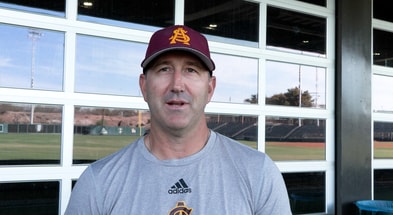Inside ASU Baseball’s Transfer Surge, Pitching Lab and Culture Reset


When the new-look Arizona State Sun Devils baseball team gathered for fall workouts, the energy was unmistakable. The roster is in transition, but not in the usual “rebuild” sense. This year’s Sun Devils blend seasoned returners, a historic transfer portal haul, and a coaching staff determined to maximize every opportunity.
At the center of it all is pitching coach Jeremy Accardo, entering his second year, and recruiting coordinator Sam Peraza, whose summer efforts reshaped the roster.
Peraza’s approach was strategic. With several key players leaving for the MLB draft, including nine selections in the top 10 rounds, and the entire outfield departing, he leaned on the transfer portal to reload quickly.
“I think we did a good job of bringing a lot of guys in here,” Peraza noted. “We are competing with some of the conferences who throw a lot of dollars out there. We don’t have that type of money. So… we got to take some chances on guys that have done it in the past.”
The goal was clear: identify players with talent, experience, and drive. Whether coming off a stellar season, overcoming injuries, or seeking a fresh start. They faced the challenge of bringing in athletes who share the same hunger for winning and a tournament appearance after returners got a taste last year.
“What we had was nine guys go inside the top 10 rounds, and our entire outfield gets drafted and goes,” Peraza added. “That helped us out a lot when it came to getting some transfers in here.”.
That strategy has created a unique dynamic. The roster now features almost as many transfers as returners. For many of those players, the challenge is immediate: carving out roles while contributing to a team with championship ambitions.
Sophomore left-hander Easton Barrett, who saw significant playing time as a freshman, logging 39.2 IP and 10 games started, remarked that the intensity of fall workouts reflects the squad’s mindset.
“We’re going to go out there and compete … we play all 27 outs hard,” Barrett explained. “Everyone’s just trying to put their best foot forward … everyone wants the spot.”
Junior infielder Dominic Longo, a Utah Valley transfer who finished 2025 hitting .306 with 11 home runs and 60 RBIs, echoed the sentiment, highlighting the team’s culture shift.
“The talent around me is amazing … everybody who’s good here makes everybody else better,” Longo claimed. “It definitely brings me to another level.”
For junior right-handed pitcher Alex Overbay, who also transferred from UNLV and served as the Rebels’ closer last year, the learning curve has involved both adjusting to the culture and mastering the nuances of the ASU program.
“It’s literally in their culture to win,” Overbay remarked.”The further you go you know the more looks you get, so if we keep winning, I think the draft will take care of itself.”
On the pitching side, Accardo’s second year brings continuity and focus. The former MLB pitcher and development expert has implemented what he describes as one of the only pitching labs on the West Coast, a facility designed to maximize development for each arm.
“We’re going to use that thing a ton,” Accardo noted. “My job is to make sure this happens, and we treat them all individually … but also surround ourselves with some core philosophies and some overall goals and see where it takes us.”
The emphasis is not just on mechanics but on confidence and mental preparedness.
“The biggest thing is having these guys run out to the field … knowing that they’re better than the hitter,” Accardo emphasized. For the staff, that mindset extends to rotation construction and daily competition.
Players are already feeling the benefits of both the lab and the coaching philosophy. Barrett explained he’s looking to further develop his slider and implement a cutter he experimented with over the summer. Overbay has been integrating a changeup, a pitch he hadn’t used extensively before, after guidance from Accardo.
“I feel like that could definitely improve my arsenal … it helps get hitters off the fastball,” Overbay noted. “Then it opens up the slider and the cutter too.”
Off the mound, Peraza faced the challenge of practically rebuilding the starting lineup, but the players he brought in offer versatility and depth, giving head coach Willie Bloomquist plenty of options.
“We built this group to have depth,” Peraza remarked. “We’ve got six infielders that could play the middle. We’ve got six outfielders for three spots.”
The goal is redundancy, creating a roster where multiple players can step in without compromising performance. That approach has already cultivated a competitive yet supportive environment. Returners like sophomore outfielder Landon Hairston, an All-Big 12 first-team selection last year who was thrust into a leadership role early, emphasized that this year’s attitude is one of shared responsibility.
“It’s not really one guy goes above the other,” Hairston explained. “It’s more so overall, just trying to figure out our roles, see what we can do for the team to make us better.
The players consistently cite culture and identity as pillars of the team’s philosophy. Fifth-year outfielder and UNLV transfer Dean Toigo, the 2025 Mountain West Co-Player of the Year, highlighted the competitiveness that’s evident in every practice.
“If you watch any of our practices, you can see that competitiveness,” Toigo added. “From the pitchers, catchers, everywhere.
Barrett emphasized that lifts, conditioning, and drills have grown in intensity compared to last year, fostering both individual and collective growth.
“It’s been really fun to just see everyone compete,” Barrett remarked, “we had a lot of lifts and like conditioning and all that, and we were just so grateful to be out here and playing finally.”
The transfer players, in particular, highlight the unique opportunity ASU provides. Overbay highlighted the opportunity to learn from veteran juniors Cole Carlon, Wyatt Halvorson, and Josh Butler, who offer both leadership and institutional knowledge.
“They’ve been super helpful,” Overbay noted. “Whether it’s pitch design or having feel within the team.”
The blend of experienced returners and motivated transfers has given the Sun Devils depth that extends beyond individual talent. Longo reflected on the collective growth.
“I think everyone here has (a chip on their shoulder). A lot of confidence here, and that’s what we need. If we wanna win, we gotta have confidence.” Longo claimed. “I’m here to play, I’m here to win. Just working hard every day, learning new things, giving my best every day is what I’m working towards.”
Accardo sees the combination of pitching talent, competitive mindset, and lab resources as a formula for both immediate success and long-term development.
“Everybody’s pulling on the same rope for one common goal,” Accardo emphasized. “That’s how we create a winning environment.” Players echo that sentiment, noting that the focus on preparation, adaptability, and accountability is already shaping routines.
Moving forward, ASU’s roster features a rotation and lineup that’s loaded with options, experienced arms complemented by newcomers, and an overall drive that promises high stakes. Rotation competition, infield battles, and outfield depth-the role for every player will be different, and each will be earned through work and consistency. The message is crystal clear: this is a team that prizes process, depth, and culture as much as raw talent.
As the Sun Devils head toward spring, both players and coaches are clear on expectations. Peraza framed it in practical terms.
“Our main goal was to win. They know they got to win,” Peraza claimed. “We get to Omaha, and it’s going to benefit everyone down the road.”
Accardo emphasized confidence and preparation, telling pitchers to trust themselves, trust the defense, and trust the process. For the players, that confidence is grounded in seeing the talent around them and the culture they’re building together.
“This group is set up to compete, day in and day out,” Barrett remarked. “We’re going to keep coming after it … everyone wants the spot. That’s what’s going to make us better as a team.”


